Discover the Genius of Alex Lifeson’s Chord Voicings
The guitarist’s complex and clever chord work are at the heart of Rush’s amazing engine
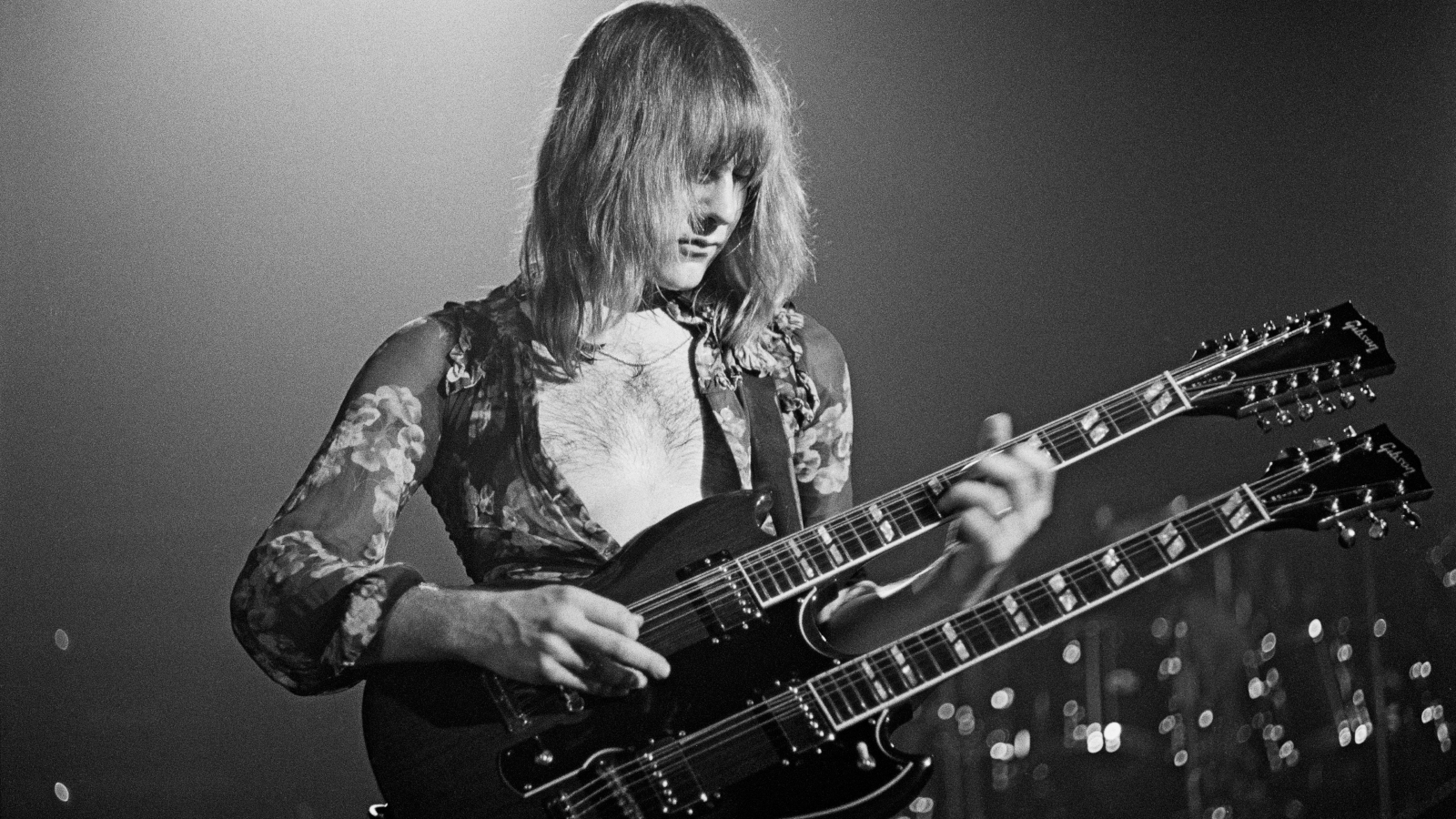
Perhaps the most accurate and astute observation of Rush’s sound I’ve ever heard came from my then-seven-year-old daughter, Sofia.
Upon hearing their classic track “The Spirit of Radio” for the first time, she concluded, “It sounds like they’re playing three songs at once… but in a good way!”
It sounds like they’re playing three songs at once… but in a good way!
Sofia DeMasi
Sofia seemed to get to the heart of the Canadian trio’s appeal – namely, their ability to seamlessly blend complexity with unbridled visceral thrill by combining elements of prog rock, heavy metal and new wave into a unique and evolving style.
From their 1974 self-titled debut album until their unofficial “retirement” in 2015 – following the triumphant Clockwork Angels album – Rush have cultivated and maintained an intensely loyal and growing fan base.
They are a particular favorite among musicians, who seem exceptionally captivated with the artistry and elite ninja-level chops of drummer Neil Peart, bassist/keyboardist/vocalist Geddy Lee and guitarist Alex Lifeson.

Despite being scorned by critics and ignored by radio for the majority of their career, Rush packed hockey arenas worldwide.
Over the course of their career, they notched 24 Gold, 14 Platinum and three multi-Platinum album awards.
All the latest guitar news, interviews, lessons, reviews, deals and more, direct to your inbox!
However, the most undeniable evidence of their status as a “people’s band” came in 2013, when they were voted into the Rock and Roll Hall of Fame by a two-to-one margin over their nearest competitor.
Not content with pedestrian open chord shapes, barre chords and power chords, he regularly sought out lush and uncommon voicings
Rush started out as a power-chord-and blues scale-driven rock trio, but their sound grew in its ambition and complexity as the group began experimenting with odd-meter grooves, extended song forms, keyboards, Moog Taurus pedals, acoustic instruments, sequencers and literary lyrical themes.
At their creative best, they were able to transcend the limits of the guitar-bass-drums power-trio format and alchemize into an expansive, multilayered orchestral sound that’s breathtaking in both ambition and execution.
Lifeson’s complex and clever chord work are at the heart of this amazing engine.
Not content with pedestrian open chord shapes, barre chords and power chords, he regularly sought out lush and uncommon voicings.
Taking a page from the Pete Townshend rhythm guitar playbook, Lifeson would emulate closed-voiced keyboard-style triads by fretting on the high strings.

Ex. 1a offers three of his favorite grips based on the top three strings of moveable open A, E and D shapes.

Ex. 1b is reminiscent of the build-up in “Discovery” from “2112” (2112), the bridge of “Red Barchetta” (Moving Pictures) and the chordal riff just before the verses in “Freewill” (Permanent Waves).
This example dynamically juxtaposes these three shapes up and down the neck against a palm-muted open-D-string pedal point.

Another hallmark of the Lifeson lexicon is his liberal use of static open strings in chord shapes that he shifts up and down the neck.
The Dadd4/2 in Ex. 2a is simply an open C chord shape shifted up two frets, while including the open G and high E strings.

Add a rolling arpeggiation pattern with the pick hand and a modulation up a minor third (three frets’ distance) to Fmaj7add2, as shown in Ex. 2b, to experience some of the melodicism of Rush ballads like “Tears” (2112) and “Different Strings” (Permanent Waves).
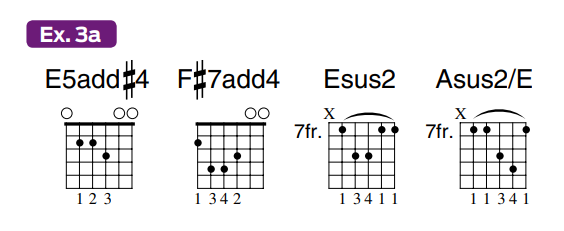
Ex. 3a illustrates some of Lifeson’s other favorite go-to chord voicings, specifically, moveable fretted shapes with the two highest strings open (E5add#4 and F#7add4) and sus2 power chords with the root on the fifth or fourth string (Esus2 and the Asus2/E).
By substituting these voicings for stock barre chords, Lifeson is able to enhance and intensify the harmonic depth and appeal of his chord work.

Dig how a basic E-F#-A-B chord pattern gets blasted into hyperspace in Ex. 3b by simply sliding the E-shape voicing of the F#7add4 chord up the neck against the open B and E strings in bars 3 and 4, and by then substituting the sus2 shapes for the second pass through the four-bar progression, beginning in bar 5.
These kinds of clever chordal tactics can be heard on the verses to “Xanadu,” (A Farewell to Kings) and “The Spirit of Radio” (Permanent Waves), as well as the “Prelude” to “Cygnus X-I Book II: Hemispheres” (Hemispheres).
The E5add#4 and F#7add4 chords also figure very prominently in the chorus of “Limelight” (Moving Pictures).
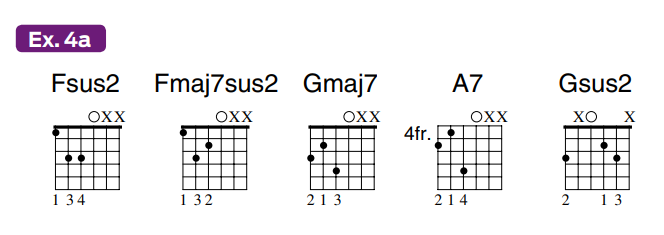
Ex. 4a demonstrates some of Lifeson’s varied arsenal of chord voicings on the three lowest strings.
For many guitarists, the basic root-fifth-octave power chord is the default low-string grip, but ever the explorer, Lifeson also incorporates root-5-major 7 (the Fmaj7sus2) and root-3-major 7 (the Gmaj7) voicings as well.
Even when grabbing a standard-issue power chord, he will often enliven it by adding an open G string (the Fsus2).
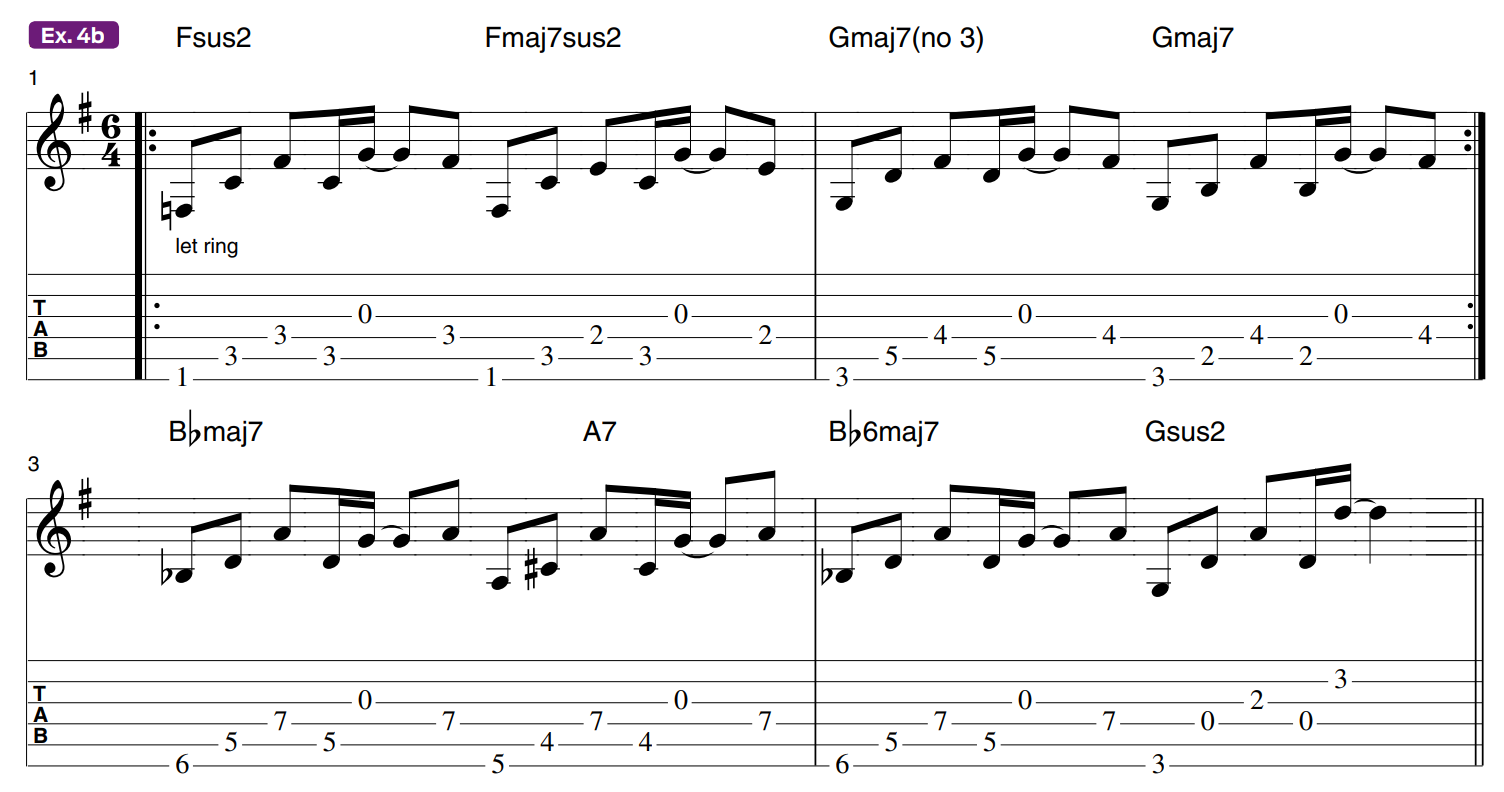
After familiarizing yourself with these chord shapes, play through Ex. 4b which, although it isn’t based on any one particular Rush song, contains elements of the first half of “Cygnus X-1 Book II: Hemispheres” (Hemispheres), the verses in “New World Man” (Signals) and the main figure of “No One at the Bridge” (Caress of Steel).
Notice the pedaling on the open G string throughout.
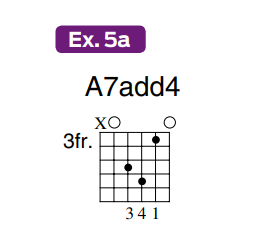
The A7add4 grip in Ex. 5a isn’t exactly what Lifeson plays during the instrumental interlude in “The Trees” (Hemispheres), but it occupies the same harmonic space.
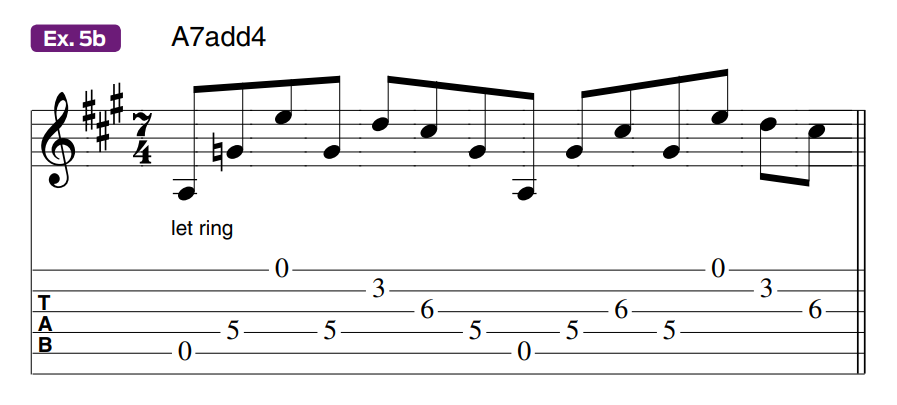
Ex. 5b, an arpeggiation of this chord, is an example of how Rush would effectively juxtapose lilting harmonic figures against jagged, odd-meter rhythmic motifs, exemplified here in 7/4 meter.

In many Rush songs, Lifeson would often hang tight on an ostinato (repeating) figure while Lee created tension by shifting bass notes underneath it, as illustrated in Ex. 5c. (Hint: in the actual version of “The Trees,” the band is grooving in 5/4 meter, and Lee plays the bass notes G, A, G and D for a measure each.)

For our final example, let’s explore how Lifeson uses a fifth-string-root B5 chord as a jump-off point for I-IV-V-Vim-based chord progressions (E-A-B-C#m) in the key of E.
Familiarize yourself with the grips shown in Ex.6a, then arpeggiate them, as demonstrated in Ex. 6b.

The “trick” here is to keep your fourth finger “planted” on the B note on the G string’s fourth fret throughout and sound the open B note, as well.
Played as arpeggios, these voicings are evocative of Lifeson’s intro riff to “Time Stand Still” (Hold Your Fire) and the verses to “Clockwork Angels” (Clockwork Angels).
Aside from his harmonic innovations, Lifeson is a sonic explorer
Additionally, if you strum the B5, Asus2 and E5 chords against a 7/4 groove you’ll get the chordal riff just before the verses in “Limelight” (Moving Pictures).
Aside from his harmonic innovations, Lifeson is a sonic explorer.
While his “signature sound” is arguably a Gibson cranked through Hughes & Kettner heads, much of his clean tone sparkle on earlier records was tracked with a Roland JC-120 amp.
Try playing these examples with a clean or slightly overdriven tone with lots of chorus and ambient delay.
More important than copying Lifeson’s licks or tone is being inspired by his exploratory spirit and dedication to his and his band’s artistic vision.
He is truly one of the greats.
